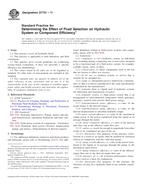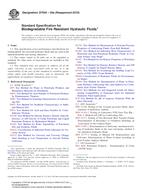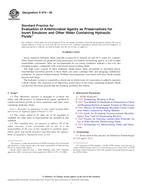We need your consent to use the individual data so that you can see information about your interests, among other things. Click "OK" to give your consent.
ASTM D7721-11
Standard Practice for Determining the Effect of Fluid Selection on Hydraulic System or Component Efficiency
STANDARD published on 1.6.2011
The information about the standard:
Designation standards: ASTM D7721-11
Note: WITHDRAWN
Publication date standards: 1.6.2011
SKU: NS-39019
The number of pages: 5
Approximate weight : 15 g (0.03 lbs)
Country: American technical standard
Category: Technical standards ASTM
The category - similar standards:
Annotation of standard text ASTM D7721-11 :
Keywords:
design of experiment, efficiency, field testing, hydraulic fluid, shear stability, ICS Number Code 75.120 (Hydraulic fluids)
Additional information
| Significance and Use | ||||||
|
The purpose of a hydraulic fluid is to cool and lubricate fluid power components, as well as transmit power. Several standard test methods are available to measure the lubrication performance of hydraulic fluids. This practice provides uniform guidelines for comparing fluids in terms of their power-transmitting abilities as reflected in their effect on hydraulic system or component efficiency. General—Energy efficiency benefits of hydraulic fluids are the differences between two large numbers. Consequently, it is essential to ensure that the differences observed are statistically valid (within defined confidence limits, typically 95%) and that proper precautions to ensure the necessary experimental controls have been put in place to compare the energy efficiency performance of two or more different hydraulic fluids under identical operating conditions. Practical advantages of enhanced hydraulic system efficiency may include increased productivity (faster machine cycle time), reduced power consumption (electricity or fuel), and reduced environmental impact (lowered emissions). This practice implies no evaluation of hydraulic fluid quality other than its effect on hydraulic system efficiency. |
||||||
| 1. Scope | ||||||
|
1.1 This practice covers all hydraulic fluids. 1.2 This practice is applicable to both laboratory and field evaluations. 1.3 This practice gives overall guidelines for conducting science-based evaluations. It does not prescribe a specific efficiency test methodology. 1.4 The values stated in SI units are to be regarded as standard. No other units of measurement are included in this standard. 1.5 This standard does not purport to address all of the safety concerns, if any, associated with its use. It is the responsibility of the user of this standard to establish appropriate safety and health practices and determine the applicability of regulatory limitations prior to use. |
||||||
| 2. Referenced Documents | ||||||
|
Similar standards:
Historical
1.10.2010
Historical
1.6.2014
Historical
1.7.2010
Historical
1.7.2010
Historical
1.10.2010
Historical
1.4.2009



 ASTM D7044-04a(2010)..
ASTM D7044-04a(2010).. ASTM D7596-14
ASTM D7596-14 ASTM D7646-10
ASTM D7646-10 ASTM D7647-10
ASTM D7647-10 ASTM D7665-10
ASTM D7665-10 ASTM E979-09
ASTM E979-09 Cookies
Cookies
